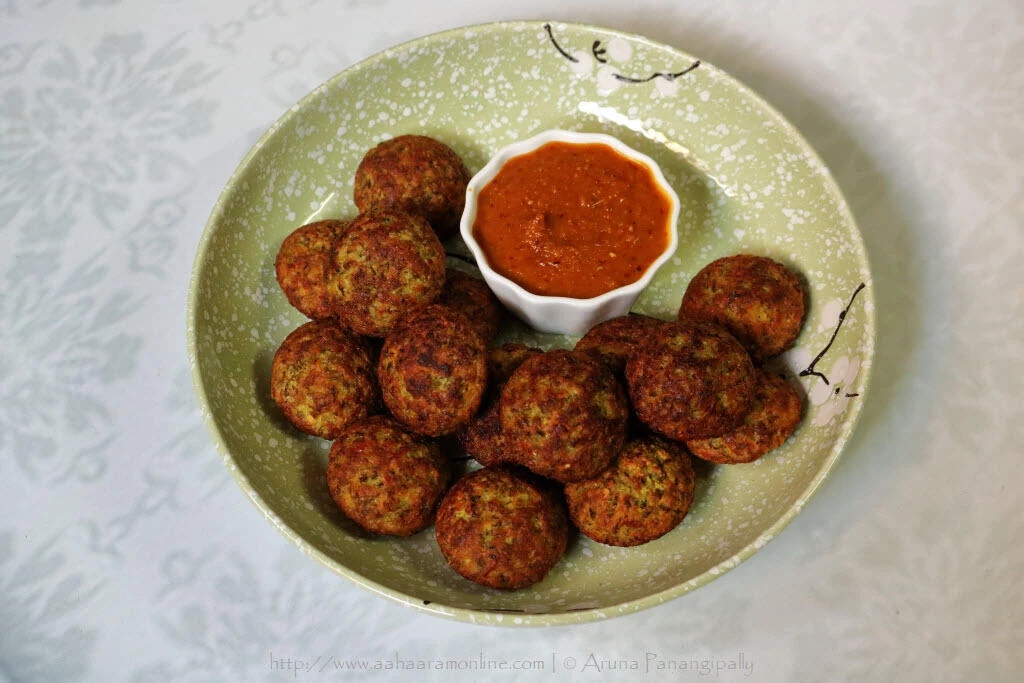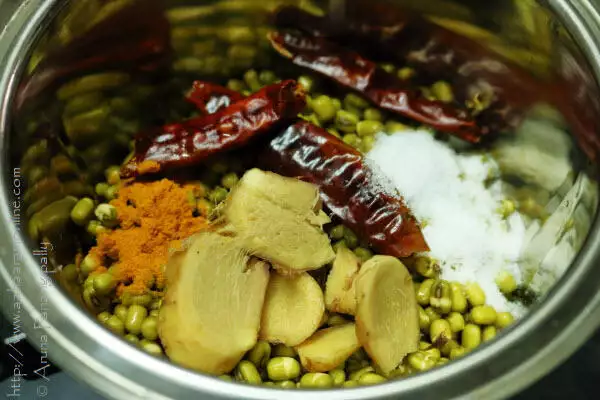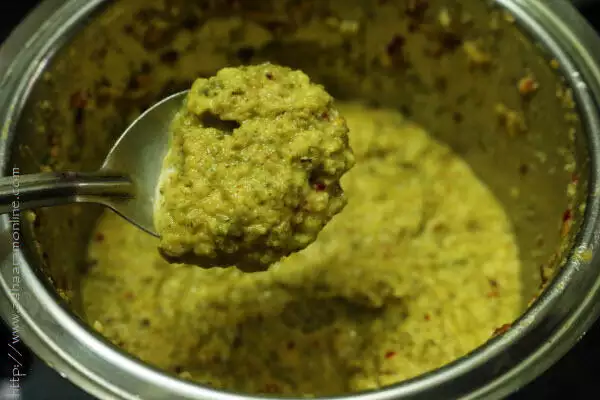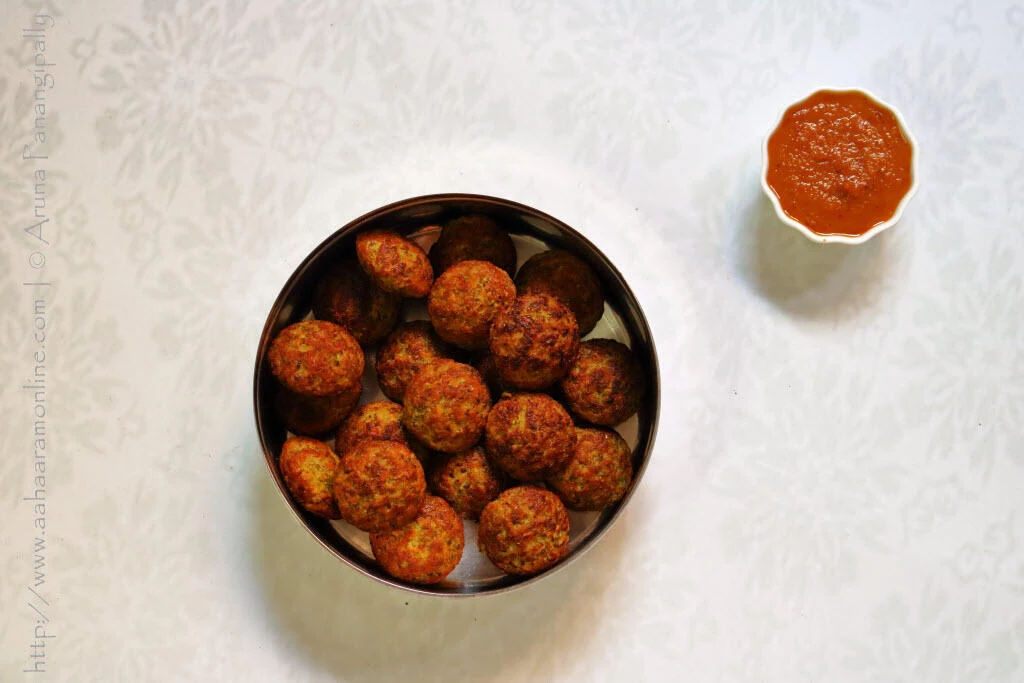So what do you do if you have left over Pesarattu batter and don’t want to make Pesarattu? You make Andhra Pesarattu Paddu or Moong Dal Paniyaram; a healthy, low-oil, high-protein snack.
Pesarattu Paddu gets done in about 20 to 30 minutes, and can be quite a makes for a very tasty snack. I served it with Allam Pachadi (Andhra Ginger Chutney).
In Andhra, Paniyaram are called Paddu or Gunta Punugulu.

Recipe for Pesarattu Paddu | Pachai Payaru Paniyaram | Whole Moong Dal Appam
Andhra Pesarattu Paddu | Pachai Payaru Paniyaram | Whole Moong Dal Appam
I used Pesarattu Pindi to make this delicious snack called Andhra Pesarattu Paddu (Gunta Punugulu). These are essentially Whole Moong Dal Paniyaram.
Ingredients
- 1/2 Cup Whole Moong, Pesalu (~125 gms)
- 2″ Piece Ginger (~20 gms)
- 3-4 Red Chillies
- 1/2 tsp Turmeric
- 1 tbsp Rice Flour (Optional; See Notes)
- Salt to Taste
- Oil or Ghee, as Required (See Notes)
Equipment
- Paniyaram Pan, Appam Pan, Ebelskiver Pan
Instructions
Making the Batter
- Wash and soak the moong for at least 6 hours.
- Drain all the water.
- Grind the soaked moong, ginger, red chillies, salt, and turmeric to a coarse paste using as little water as possible. The batter should be thick and fall off the spoon.
Making the Pesarattu Paddu | Moong Dal Paniyaram
- If you are using rice flour, add it to the batter and mix well.
- Over medium flame, heat the appam pan.
- Add a few drops of oil to each cavity.
- Fill 3/4 of each cavity with the batter. The paniyaram will swell a bit as they are cooking.
- Cook over medium flame for 2 minutes or till the side touching the pan is golden brown. I use a paring knife to gently lift the paniyaram to check for brownness.
- Using a small knife, flip the paniyaram.
- Drizzle a few drops of oil or ghee along the edges.
- Let the paniyaram cook till the flip side is also golden brown.
- Remove and serve hot with Allam Pachadi.
Notes
- The rice flour makes the Paddu crisp.
- Do make these in ghee, if possible, as it lends a distinct flavour. Also, ghee helps in digesting the relatively heavy moong dal.

How to Make Pesarattu Paddu | Whole Moong Dal Paniyaram| Pachai Payaru Paniyaram
- Making the Batter
- Wash the moong dal well and soak it in 2 cups water for 6 hours or more. The moong will almost double in volume. In colder weather, use warm (not hot) water to soak and soak for a longer time.
- Drain all the water from the moong.
- Add the moong, ginger, red chillies, salt, and turmeric to a mixer.

- Grind to a coarse batter using as little water as possible. Do not make the batter smooth because then the Paniyaram will be very dense and may become hard. The batter should be thick and fall off the spoon. If the batter has water, once again the Paniyaram will be hard and also burn because you have to cook for a long time.

- Making the Pesarattu Paddu | Moong Dal Paniyaram
- If you are using rice flour, add it to the batter and mix well. The rice flour gives a nice crispness. Do not add too much because then the Paniyaram will brown very quickly and burn.
- Over medium flame, heat the appam pan. The pan must be warm before you add the batter, otherwise the texture changes.
- Add a few drops of oil or ghee to each cavity. Ghee is recommended as it lends a lovely aroma and flavour. It also helps in digesting the moong easily. 🙂
- Fill 3/4 of each cavity with the batter. The paddu will swell a bit as they are cooking.

- Cook the paddu over medium flame for 2 minutes or till the side touching the pan is golden brown. I use a small knife to gently lift the appam to check for brownness.
- Using a small knife, loosen the edges of each paniyaram and flip it over.

- Drizzle a few drops of oil or ghee along the edges.
- Let the Pesarattu Paddu cook till the flip side is also golden brown.
- Remove and serve hot with Allam Pachadi.




The best way to consume leftover batters is to make paniyarams and the pesarattu paniyarams are even more healthy with moong dal. Plus they are super filling until lunch time. Loved that pachadi on the side.